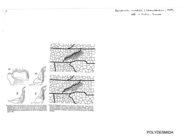MilliBase
MilliBase taxon details
Howellaria infesta (Chamberlin, 1918)
1496272 (urn:lsid:marinespecies.org:taxname:1496272)
accepted
Species
Aporiaria brunnior Chamberlin, 1943 · unaccepted
Aporiaria geniculata Chamberlin, 1939 · unaccepted
Boraria infesta (Chamberlin, 1918) · unaccepted
Boraria media (Chamberlin, 1918) · unaccepted
Nannaria infesta Chamberlin, 1918 · unaccepted
Nannaria media Chamberlin, 1918 · unaccepted
(of Nannaria infesta Chamberlin, 1918) Chamberlin, R. V. (1918). New polydesmoid diplopods from Tennessee and Mississippi. Psyche. 25: 122-127.
page(s): 126 [details]
page(s): 126 [details]
Holotype (of Nannaria infesta Chamberlin, 1918) MCZ
, Type locality contained in North Carolina
Holotype (of Nannaria infesta Chamberlin, 1918) MCZ [details]
type locality contained in North Carolina [from synonym] [view taxon] [details]
Sierwald, P.; Decker, P.; Spelda, J. (2024). MilliBase. Howellaria infesta (Chamberlin, 1918). Accessed at: https://www.millibase.org/aphia.php?p=taxdetails&id=1496272 on 2025-04-08
original description
(of Aporiaria brunnior Chamberlin, 1943) Chamberlin, R. V. (1943). On nine North American polydesmoid millipeds. Proceedings of the Biological Society of Washington, 56: 35-40
page(s): 37 [details]
original description (of Aporiaria geniculata Chamberlin, 1939) Chamberlin, R. V. (1939). On some diplopods of the family Fontariidae. Bulletin of the University of Utah, Biological Series. 30(2): 1-19. Salt Lake City.
page(s): 6 [details]
original description (of Nannaria media Chamberlin, 1918) Chamberlin, R. V. (1918). New polydesmoid diplopods from Tennessee and Mississippi. Psyche. 25: 122-127.
page(s): 125 [details]
original description (of Nannaria infesta Chamberlin, 1918) Chamberlin, R. V. (1918). New polydesmoid diplopods from Tennessee and Mississippi. Psyche. 25: 122-127.
page(s): 126 [details]
additional source McAllister, C. T.; Remsen, D. (2024). A New State Record for the Milliped, Howellaria infesta (Diplopoda: Polydesmida: Xystodesmidae). Entomological News. 131(2)., available online at https://doi.org/10.3157/021.131.0201 [details] Available for editors
status source Means, J. C.; Hennen, D. A.; Tanabe, T.; Marek, P. E. (2021). Phylogenetic Systematics of the Millipede Family Xystodesmidae. Insect Systematics and Diversity. 5(2)., available online at https://doi.org/10.1093/isd/ixab003
page(s): 23; note: In the case of Howellaria infesta (Chamberlin, 1918), Howellaria deturkiana (Causey, 1942), and Idaloria profuga—once members of the genus Boraria—these species are not monophyletic with Borar...
[details] Available for editors 
page(s): 37 [details]
original description (of Aporiaria geniculata Chamberlin, 1939) Chamberlin, R. V. (1939). On some diplopods of the family Fontariidae. Bulletin of the University of Utah, Biological Series. 30(2): 1-19. Salt Lake City.
page(s): 6 [details]
original description (of Nannaria media Chamberlin, 1918) Chamberlin, R. V. (1918). New polydesmoid diplopods from Tennessee and Mississippi. Psyche. 25: 122-127.
page(s): 125 [details]
original description (of Nannaria infesta Chamberlin, 1918) Chamberlin, R. V. (1918). New polydesmoid diplopods from Tennessee and Mississippi. Psyche. 25: 122-127.
page(s): 126 [details]
additional source McAllister, C. T.; Remsen, D. (2024). A New State Record for the Milliped, Howellaria infesta (Diplopoda: Polydesmida: Xystodesmidae). Entomological News. 131(2)., available online at https://doi.org/10.3157/021.131.0201 [details] Available for editors
status source Means, J. C.; Hennen, D. A.; Tanabe, T.; Marek, P. E. (2021). Phylogenetic Systematics of the Millipede Family Xystodesmidae. Insect Systematics and Diversity. 5(2)., available online at https://doi.org/10.1093/isd/ixab003
page(s): 23; note: In the case of Howellaria infesta (Chamberlin, 1918), Howellaria deturkiana (Causey, 1942), and Idaloria profuga—once members of the genus Boraria—these species are not monophyletic with Borar...
In the case of Howellaria infesta (Chamberlin, 1918), Howellaria
deturkiana (Causey, 1942), and Idaloria profuga—once members of
the genus Boraria—these species are not monophyletic with Boraria
stricta (Brölemann, 1896), the type species of the genus, and are given
their own names.
 Present
Present  Inaccurate
Inaccurate  Introduced: alien
Introduced: alien  Containing type locality
Containing type locality
- Type locality
- type locality contained in North Carolina [from synonym] [view taxon] [details]
- From editor or global species database
- United States
- (no group)
Holotype (of Nannaria infesta Chamberlin, 1918) MCZ [details]
To Barcode of Life (1 barcode) (from synonym Boraria media (Chamberlin, 1918))
To European Nucleotide Archive, ENA (Boraria infesta) (from synonym Boraria infesta (Chamberlin, 1918))
To European Nucleotide Archive, ENA (Boraria media) (from synonym Boraria media (Chamberlin, 1918))
To GenBank (1 nucleotides; 0 proteins) (from synonym Boraria infesta (Chamberlin, 1918))
To GenBank (3 nucleotides; 2 proteins) (from synonym Boraria media (Chamberlin, 1918))
To European Nucleotide Archive, ENA (Boraria infesta) (from synonym Boraria infesta (Chamberlin, 1918))
To European Nucleotide Archive, ENA (Boraria media) (from synonym Boraria media (Chamberlin, 1918))
To GenBank (1 nucleotides; 0 proteins) (from synonym Boraria infesta (Chamberlin, 1918))
To GenBank (3 nucleotides; 2 proteins) (from synonym Boraria media (Chamberlin, 1918))


